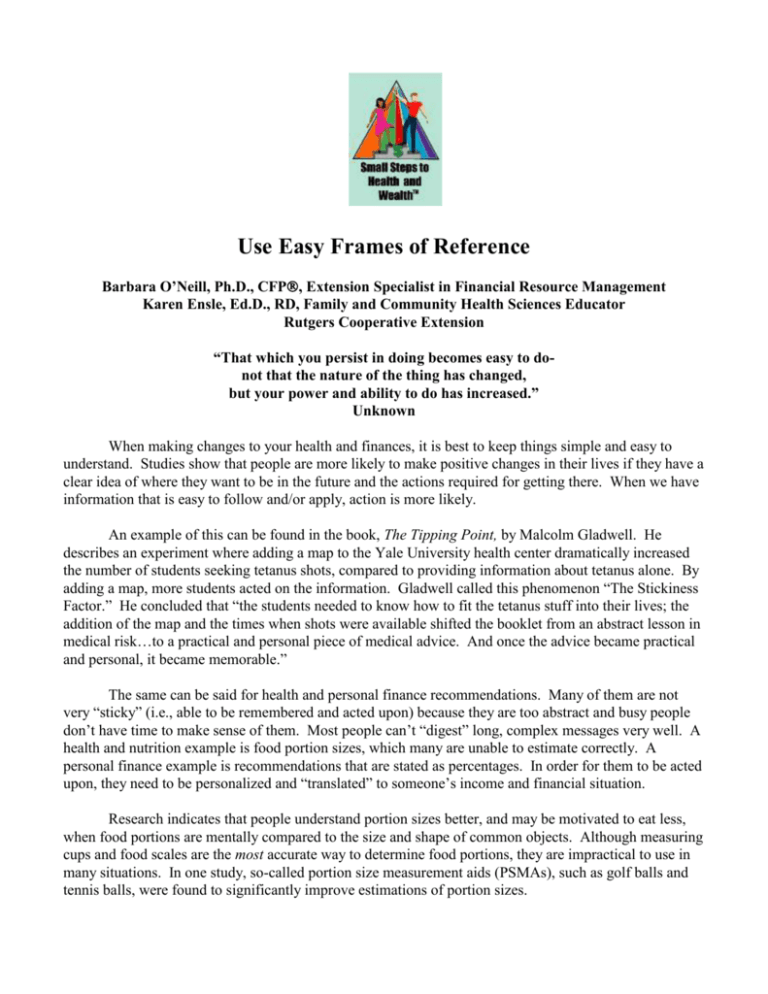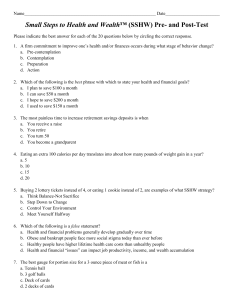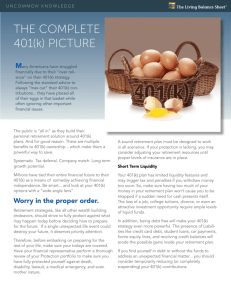Use Easy Frames of Reference
advertisement

Use Easy Frames of Reference Barbara O’Neill, Ph.D., CFP, Extension Specialist in Financial Resource Management Karen Ensle, Ed.D., RD, Family and Community Health Sciences Educator Rutgers Cooperative Extension “That which you persist in doing becomes easy to donot that the nature of the thing has changed, but your power and ability to do has increased.” Unknown When making changes to your health and finances, it is best to keep things simple and easy to understand. Studies show that people are more likely to make positive changes in their lives if they have a clear idea of where they want to be in the future and the actions required for getting there. When we have information that is easy to follow and/or apply, action is more likely. An example of this can be found in the book, The Tipping Point, by Malcolm Gladwell. He describes an experiment where adding a map to the Yale University health center dramatically increased the number of students seeking tetanus shots, compared to providing information about tetanus alone. By adding a map, more students acted on the information. Gladwell called this phenomenon “The Stickiness Factor.” He concluded that “the students needed to know how to fit the tetanus stuff into their lives; the addition of the map and the times when shots were available shifted the booklet from an abstract lesson in medical risk…to a practical and personal piece of medical advice. And once the advice became practical and personal, it became memorable.” The same can be said for health and personal finance recommendations. Many of them are not very “sticky” (i.e., able to be remembered and acted upon) because they are too abstract and busy people don’t have time to make sense of them. Most people can’t “digest” long, complex messages very well. A health and nutrition example is food portion sizes, which many are unable to estimate correctly. A personal finance example is recommendations that are stated as percentages. In order for them to be acted upon, they need to be personalized and “translated” to someone’s income and financial situation. Research indicates that people understand portion sizes better, and may be motivated to eat less, when food portions are mentally compared to the size and shape of common objects. Although measuring cups and food scales are the most accurate way to determine food portions, they are impractical to use in many situations. In one study, so-called portion size measurement aids (PSMAs), such as golf balls and tennis balls, were found to significantly improve estimations of portion sizes. Some examples of PSMAs are listed in the table below: Portion Size Measurement Aids Food 2 oz bagel 3 oz of meat 1 tsp. butter or margarine ½ cup rice 2 tbsp. of peanut butter ¼ cup dried fruit 1 ½ oz of cheese 1 oz nuts or candies 1 cup rice or pasta Medium piece of fruit 1 tbsp. of salad dressing 1 cup salad greens Portion Size Measurement Aid 2 decks of cards 1 deck of cards 1 postage stamp (1/4” thick) 2 golf balls 1 golf ball 1 golf ball ½ golf ball or 3 dice 1 handful 1 tennis ball 1 tennis ball 1 thumb tip (from thumb joint) 1 baseball Financial recommendations often fail to be acted upon because they are stated as percentages or require mathematical calculations. Like the tetanus booklet without a map, advice can seem impersonal and incomplete. Percentages are hard to relate to. Nevertheless, if you take the time to understand these guidelines and convert percentages into dollar figures, they can prove quite helpful. Below are some common financial recommendations, translated into dollars, with examples based on a worker with a $50,000 gross income. Note that some are broken down even further into smaller increments. Financial Frames of Reference in Dollar Terms-Based on a $50,000 Annual Income Financial Guideline Translation Into “User-Friendly” Dollar Terms Save at least the amount that your employer will match in a tax-deferred 401(k) or 403(b) plan. Find out the maximum amount of worker contributions that your employer will match. If your employer matches 6% of pay, save $3,000 and you’ll receive $3,000 in “free money.” $3,000 of annual savings requires weekly savings of about $58. Plan for at least 70% to 80% of pre-retirement income to live comfortably in retirement. 70% to 80% of a $50,000 income is a $35,000 to $40,000 income in retirement. 75% is $37,500. Personalized savings calculations are best, however, rather than relying on general guidelines. Save 10% of gross income if you’re a young adult and up to 15% to 20% of gross income if you are a middle-aged “late saver” in your late 30s and 40s with no retirement savings. A young worker would save $5,000 annually and an older worker, $7,500 to $10,000. If these amounts are difficult to achieve, start saving less but gradually increase the percentage over time. Buy a house that costs no more than 2 ½ times your annual income. Housing should cost no more than $125,000 for those with a $50,000 income (Note: this may be difficult to do in pricey areas). Purchase disability insurance equal to 60% to 70% of your gross income. A worker earning $50,000 should have coverage ranging from $30,000 ($2,500 monthly) to $35,000 ($2,915 monthly). When you retire, withdraw 4% of your portfolio annually, increasing the amount with inflation each year, to avoid running out of money. If, at age 65, you have $400,000 saved for retirement, you should withdraw $16,000 (400,000 x .04) in the first year and then increase this amount each year for inflation (e.g., $16,000 x 3% inflation = $480 for a total withdrawal of $16,480 in year 2). Rebalance your investment portfolio when asset class weightings drift 5% to 10% from their original percentage. If 50% ($10,000) of a $20,000 portfolio is invested in stock and the other 50% in fixed-income securities, the portfolio should be rebalanced if either asset class increases by $500 to $1,000. Buy mutual funds with low expense ratios (annual fund operation and management expenses as a percentage of portfolio assets). Typically, expense ratios range from .20% (generally for low-cost index funds) to 2.0%. With a $10,000 fund balance, a .20 expense ratio (onefifth of 1%) costs $20 (10,000 x .0020) per year, a 1.3% expense ratio costs $130 (10,000 x .0130), and a 2.0% ratio costs $200 (10,000 x .0200). Over time, high expense ratios steadily erode fund returns and should generally be avoided when selecting funds. Each time you get a future pay increase, keep half and use half to increase tax-deferred retirement plan savings. If you get a 4% raise to a $50,000 income ($2,000), keep/spend $1,000 and contribute an additional $1,000 to your 401(k) or 403(b) retirement savings plan. Invest in employer tax-deferred retirement savings plans because contributions are made with “before-tax dollars.” Your contribution is offset by tax savings based on your federal marginal tax bracket. If you contribute $3,000 to a 401(k) or 403(b) plan, your taxable income would be $47,000 instead of $50,000. If you are in the 25% federal marginal tax bracket, you would save $750 (3,000 x .25) in taxes that you would otherwise pay. Thanks to this tax savings, the actual (after-tax) cost of a $3,000 retirement plan deposit is only $2,250. Purchase life insurance equal to six to 10 times your annual income. Someone earning $50,000 with dependents and a need for insurance may need to purchase from $300,000 to $500,000 of life insurance. Personalized insurance calculations are best, however, to account for survivor needs (e.g., spousal earnings, college fund, etc.). Buy bonds to provide diversification and/or periodic income during retirement. Bond interest is generally paid semi-annually and based upon the coupon (interest) rate of a bond at the time that it is issued. Assume that a newly issued $1,000 bond has a coupon rate of 6%. This means that you will receive a total of $60 of interest income (1,000 x .06) each year through maturity, payable in two $30 semi-annual payments. Note: The above examples are illustrations of financial guidelines and will vary from person to person Use the Frame of Reference Worksheet, below, to list personal applications to health and wealth. List up to three easy frames of reference that you plan to use to make health and financial decisions. Frame of Reference Worksheet List up to three easy frames of reference for both health and wealth that you plan to use to make health and financial decisions. Health Goal Wealth Goal 1 1 2. 2. 3. 3. Action Steps Health Memorize 2-3 portion size measurement aid examples and use them for food portion decisions. Pay increased attention to portion (serving) size labeling information on nutrition facts labels. Create and carry around a “cheat sheet” with the serving size and caloric value of commonly eaten foods that lack nutrition facts labels (e.g., meat, fish, produce, fast foods). Wealth Convert 2-3 of the above financial guidelines into dollar figures using personal financial data. Pay increased attention to information about mutual fund expenses in fund prospectuses. Calculate the tax savings available by making a contribution to a tax-deferred employer retirement savings plan. References Brennan, P.Q. & O’Neill, B.M. (2004). Money talk: A financial guide for women. Ithaca, NY: Natural Resource, Agriculture, and Engineering Service. Building wealth: A beginner’s guide to securing your financial future (2002). Dallas, TX: Federal Reserve Bank of Dallas. Byrd-Bredbenner, C. and Schwartz, J. (2004) The effect of practical portion size measurement aids (PSMAs) on the accuracy of portion size estimates made by young adults. Journal of Human Nutrition and Dietetics, 17:351-357. Clements, J. (1995, Dec. 5). Some rules of thumb should be ruled out. The Wall Street Journal, C1. Determining the ‘all-in’ costs of your IRA. (2004, Spring). In the Vanguard, The Vanguard Group, 3. Garman, E.T. & Forgue, R.E. (2006). Personal finance (8th Ed.). Boston: Houghton Mifflin Company. Gladwell, M. (2002). The tipping point: How little things can make a big difference. New York: Little, Brown, and Company. Investing for your future: A Cooperative Extension System basic investing home study course (2002). Ithaca, NY: Natural Resource, Agriculture, and Engineering Service and www.investing.rutgers.edu. Kreitler, R.P. (2004, July). Establishing retirement savings standards for Americans. Journal of Financial Planning, 17(7), 16-17. Milligan, E. (2003). Tips from the top: Targeted advice from America’s top money minds. Indianapolis, IN: Alpha Books. Motivating Americans to develop constructive financial behaviors: A think tank sponsored by the National Endowment for Financial Education (2004). Financial Counseling & Planning, 15(2), 39-49. O’Neill, B. (2004, December). Small Steps to Health and Wealth The Forum For Family and Consumer Issues 9(3), 8 pages. Retrieved from www.ces.ncsu.edu/depts/fcs/pub/9_3/smallsteps.html. O’Neill, B. (2002). Twelve components of financial wellness. Journal of Family and Consumer Sciences, 94(4), 53-58. O’Neill, B. (1999). Investing on a shoestring. Chicago: Dearborn Financial Publishing. Savings fitness: A guide to your money and your financial future (no date). Washington, DC: U.S. Department of Labor, Employee Benefits Security Administration. Schwartz, J. (2004). Portion distortion: Why waistlines are expanding and what to do about it. Visions, 17(2), 7. Retrieved from: www.rce.rutgers.edu/pubs/visions/vis17-2.pdf. Schwartz, J. and Byrd-Bredbenner, C. (2003) A comparison of two practical portion size measurement aids (PSMAs) for Fruits, Vegetables & Grains. Journal of the American Dietetic Association, 103:A-19.







